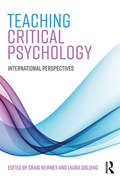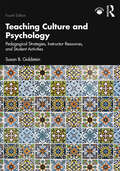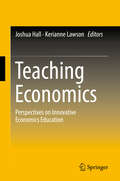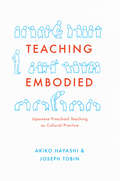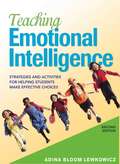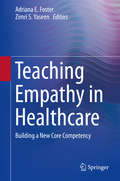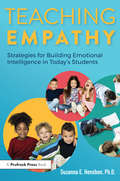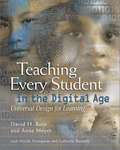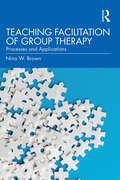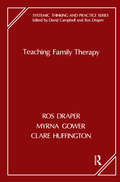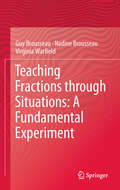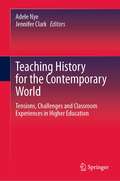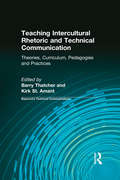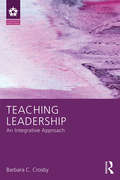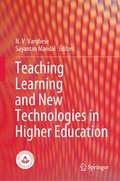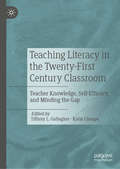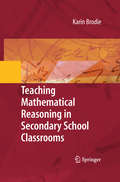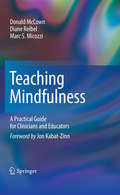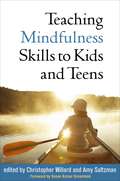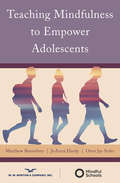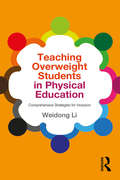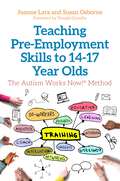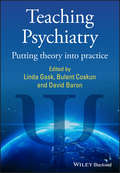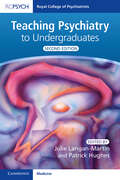- Table View
- List View
Teaching Critical Psychology: International Perspectives
by Craig Newnes and Laura GoldingThis edited volume may be the 'definitive text' on methods and content in teaching psychology from an international and critical perspective. Chapters from internationally renowned contributors working clinically, educationally and in the community with a range of client groups, outline critical teaching by and for professionals and service recipients. This timely book offers a unique, research-based and philosophically coherent approach to teaching psychology including teaching methods, the lecture content of radical approaches to modern psychology and debates as to whether the aim of teaching is to liberate or control. Themes include the nature of pedagogy, the importance of teaching and learning style, the relevance of context and content and the ways in which traditional teaching forms a part of the disciplinary rather than critical project. Teaching Critical Psychology offers guidance in teaching pupils, students, peers and those on academic programmes at under-graduate and post-graduate level.
Teaching Culture and Psychology: Pedagogical Strategies, Instructor Resources, and Student Activities
by Susan B. GoldsteinThe fourth edition of Teaching Culture and Psychology (previously Cross-Cultural Explorations) provides an array of carefully designed instructor resources and student activities that support the construction and implementation of courses on culture and psychology.Revised and expanded from previous editions, the book enables instructors to use selected activities appropriate for their course structure. Part One explores a variety of pedagogical challenges involved in teaching about culture and psychology and details specific strategies for addressing these challenges. Part Two (instructor resources) and Part Three (student handouts) center around 90 activities designed to encourage students to think critically about the role of culture in a wide range of psychology content areas. These activities are based on current and classic cross-cultural research and take the form of case studies, self-administered scales, mini-experiments, database search assignments, and the collection of content-analytic, observational, and interview data. For each activity, instructors are provided with a lecture/discussion module as well as suggestions for variations and expanded writing assignments. Student handouts are available in this text as well as on the Routledge website as fillable forms.Contributing to the inclusion of cultural perspectives in the psychology curriculum, this wide-ranging book enables instructors to provide students with hands-on experiences that facilitate the understanding and application of major concepts and principles in the study of culture and psychology, making it ideal for cultural psychology, anthropology, sociology, and related courses.
Teaching Economics: Perspectives on Innovative Economics Education
by Joshua Hall Kerianne LawsonThis book looks at a number of topics in economic education, presenting multiple perspectives from those in the field to anyone interested in teaching economics. Using anecdotes, classroom experiments and surveys, the contributing authors show that, with some different or new techniques, teaching economics can be more engaging for students and help them better retain what they learned. Chapters cover a wide range of approaches to teaching economics, from interactive approaches such as utilizing video games and Econ Beats, to more rigorous examinations of government policies, market outcomes and exploring case studies from specific courses. Many of the chapters incorporate game theory and provide worked out examples of games designed to help students with intuitive retention of the material, and these games can be replicated in any economics classroom. While the exercises are geared towards college-level economics students, instructors can draw inspiration for course lectures from the various approaches taken here and utilize them at any level of teaching. This book will be very useful to instructors in economics interested in bringing innovative teaching methods into the classroom.
Teaching Embodied: Cultural Practice in Japanese Preschools
by Joseph Tobin Akiko HayashiWhen we look beyond lesson planning and curricula--those explicit facets that comprise so much of our discussion about education--we remember that teaching is an inherently social activity, shaped by a rich array of implicit habits, comportments, and ways of communicating. This is as true in the United States as it is in Japan, where Akiko Hayashi and Joseph Tobin have long studied early education from a cross-cultural perspective. Taking readers inside the classrooms of Japanese preschools, Teaching Embodied explores the everyday, implicit behaviors that form a crucially important--but grossly understudied--aspect of educational practice. Akiko Hayashi and Joseph Tobin embed themselves in the classrooms of three different teachers at three different schools to examine how teachers act, think, and talk. Drawing on extended interviews, their own real-time observations, and hours of video footage, they focus on how teachers embody their lessons: how they use their hands to gesture, comfort, or discipli≠ how they direct their posture, gaze, or physical location to indicate degrees of attention; and how they use the tone of their voice to communicate empathy, frustration, disapproval, or enthusiasm. Comparing teachers across schools and over time, they offer an illuminating analysis of the gestures that comprise a total body language, something that, while hardly ever explicitly discussed, the teachers all share to a remarkable degree. Showcasing the tremendous importance of--and dearth of attention to--this body language, they offer a powerful new inroad into educational study and practice, a deeper understanding of how teaching actually works, no matter what culture or country it is being practiced in.
Teaching Emotional Intelligence: Strategies and Activities for Helping Students Make Effective Choices
by Adina LewkowiczA teacher's guide that provides educators with fresh and engaging techniques to help children increase self-awareness, manage emotions, build self-control, and develop positive relationships.
Teaching Empathy in Healthcare: Building a New Core Competency
by Adriana E. Foster Zimri S. YaseenEmpathy is essential to effectively engaging patients as partners in care. Clinicians’ empathy is increasingly understood as a professional competency, a mode and process of relating that can be learned and taught. Communication and empathy training are penetrating healthcare professions curricula as knowledge about the most effective modalities to train, maintain, and deepen empathy grows. This book draws on a wide range of contributors across many disciplines, and takes an evidence-based and longitudinal approach to clinical empathy education. It takes the reader on an engaging journey from understanding what empathy is (and how it can be measured), to approaches to empathy education informed by those understandings. It elaborates the benefits of embedding empathy training in graduate and post-graduate curricula and the importance of teaching empathy in accord with the clinician’s stage of professional development. Finally, it examines systemic perspectives on empathy and empathy education in the clinical setting, addressing issues such as equity, stigma, and law. Each section is full of the latest evidence-based research, including, notably, the advances that have been made over recent decades in the neurobiology of empathy.Perspectives among the interdisciplinary chapters include: Neurobiology of empathy Measuring empathy in healthcare Teaching clinicians about affect Teaching cultural humility: Understanding the core of others by reflecting on ours Empathy and implicit bias: Can empathy training improve equity? Teaching Empathy in Healthcare: Building a New Core Competency takes an innovative and comprehensive approach towards a developed understanding of empathy in the clinical context. This evidence-based book is set to become a classic text on the topic of empathy in healthcare settings, and will appeal to a broad readership of clinicians, educators, and researchers in clinical medicine, neuroscience, behavioral health, and the social sciences, leaders in educational and professional organizations, and anyone interested in the healthcare services they utilize.
Teaching Empathy: Strategies for Building Emotional Intelligence in Today's Students
by Suzanna E. HenshonAs classrooms become more diverse, it is increasingly important that students learn how to empathize with others who may come from very different backgrounds. Teaching Empathy:
Teaching English for Academic Purposes: Studies From An English-medium University (English Language Education #14)
by Clay Williams Rachael RueggThis book focuses on appropriate English for Academic Purposes instructional concepts and methods in the Japanese context. It investigates a variety of pedagogical techniques, addressing the fundamental academic English skills – listening, speaking, reading and writing – as well as assessment and materials development. All the research included was conducted in Japanese university settings, thus shedding new light on the effective implementation of EAP teaching and learning activities with Japanese learners of English. This book is of interest to anyone working in an EAP context at the secondary or tertiary level, especially those which include Japanese learners.
Teaching Every Student in the Digital Age: Universal Design for Learning
by David Rose Anne MeyerThis book presents principles and applications of Universal Design for Learning (UDL), a research-based framework for responding to individual learning differences and a blueprint for the modern redesign of education. Early chapters lay out the foundation of UDL, describing neuroscience research on learning differences, the uses of digital media in the classroom, and the creation of flexible curricula. Later chapters show how to set appropriate goals for each student, how to choose methods and materials, and how to assess students' progress. The authors are cofounders and codirectors of the Center for Applied Special Technology. Annotation c. Book News, Inc. , Portland, OR (booknews. com)
Teaching Facilitation of Group Therapy: Processes and Applications
by Nina W. BrownTeaching Facilitation of Group Therapy explores an extensive range of topics crucial to effective teaching and practice, and will be a valuable resource for instructors of group therapy. With an emphasis on evidence-based methodologies, this book describes proven teaching techniques that foster a dynamic learning environment, facilitate group cohesion, and promote meaningful interventions. The author presents ethical considerations including those that relate to using social media in therapeutic practices, equipping readers with the knowledge to leverage its potential while safeguarding client confidentiality and well-being. This resource presents topics including therapeutic factors and effective interventions, the use of the group leader’s inner development as a guide for therapeutic alliance and group members’ healing, cutting-edge therapeutic AI applications, the role of self-absorption for members and the leader, group dynamics, ethical uses of social media in therapeutic settings, and serves as a comprehensive guide for instructors in the art of teaching group psychotherapy in the modern era. This is an indispensable resource for educators to elevate their expertise in teaching group psychotherapy and prepare clinicians and students by deepening their understanding of group dynamics, and how to employ effective interventions that promote healing and growth in therapeutic settings.
Teaching Family Therapy (The Systemic Thinking and Practice Series)
by Ros Draper Clare Huffington Myrna Gower Rosemary WhiffenThe teaching of family therapy has been the subject of serious scrutiny since the onset of training and accreditation many years ago, yet there are relatively few attempts to apply what we know about systems and the ways they change family therapy teaching as a two-way process. It is as though family therapy teachers were preoccupied with the content of what should be taught, and were not able to direct their attention to the process by which people learned. The authors began by describing the way they conceptualize the "learning context" which sets the frame for all the teaching they do. Then they discuss the process of setting up a family therapy course, e.g. "What is the best way to negotiate with a training officer to set up a course in a local area?". The book then moves to creating the course syllabus, and some of the practical problems-from lateness to mechanical failures-of getting the course off the ground.
Teaching Fractions through Situations: A Fundamental Experiment
by Virginia Warfield Nadine Brousseau Guy BrousseauThis work presents one of the original and fundamental experiments of Didactique, a research program whose underlying tenet is that Mathematics Education research should be solidly based on scientific observation. Here the observations are of a series of adventures that were astonishing for both the students and the teachers: the reinvention of fractions and of decimal numbers in a sequence of lessons and situations that permitted the students to construct the concepts for themselves. The book leads the reader through the highlights of the sequence's structure and some of the reasoning behind the lesson choices. It then presents explanations of some of the principal concepts of the Theory of Situations. In the process, it offers the reader the opportunity to join a lively set of fifth graders as they experience a particularly attractive set of lessons and master a topic that baffles many of their contemporaries.
Teaching History for the Contemporary World: Tensions, Challenges and Classroom Experiences in Higher Education
by Jennifer Clark Adele NyeThis book brings together history educators from Australia and around the world to tell their own personal stories and how they approach teaching history in the context of contemporary tensions in the classroom. It encourages historians to think actively about how history in the classroom can play a role in helping students to make sense of their world and to act honourably within it.The contributors come from diverse backgrounds and include experienced history educators and early career academics. They showcase both a mix of approaches and democratize and decolonize the academy. The book blends theory and practice. It reflects on what is happening in the classroom and supports the discipline to understanding itself better, to improve upon its practices and to engage in academic discussion about the responsibility of teaching in the contemporary world.
Teaching Intercultural Rhetoric and Technical Communication: Theories, Curriculum, Pedagogies and Practice (Baywood's Technical Communications)
by Kirk St. Amant Barry Thatcher Charles H SidesIn today's integrated global economy, technical communicators often collaborate in international production teams, work with experts in overseas subject matter, or coordinate documentation for the international release of products. Working effectively in such situations requires technical communicators to acquire a specialized knowledge of culture and communication. This book provides readers with the information needed to integrate aspects of intercultural communication into different educational settings.
Teaching Leadership: An Integrative Approach (Leadership: Research and Practice)
by Barbara C. CrosbyTeaching Leadership provides guidance for leadership educators in a variety of organizational and community contexts and across academic disciplines. An experienced leadership educator, Crosby promotes an inclusive vision of leadership that recognizes the inherent leadership potential in everyone. Featuring interviews with 25 respected leadership educators, Teaching Leadership complicates and enriches the leader-follower dichotomy to advance a holistic and practice-oriented model of leadership education. Using the metaphor of ‘heart, head, and hands,’ Crosby shows how authentic leadership is an embodied practice based equally in emotional, intellectual, and experiential learning.
Teaching Learning and New Technologies in Higher Education
by N. V. Varghese Sayantan MandalThis book discusses emerging issues related to teaching-learning in Indian higher education and the integration of technology. It brings together a host of national and international experts specializing in various aspects of teaching-learning in higher education, technology, and classroom practices to present policy and organizational strategies for enhancing innovation in teaching-learning processes, and offers a comprehensive overview of teaching-learning in connection with broader themes and concerns such as academic freedom, globalization, and new technologies. Reviewing a wide range of current practices and discussing specific teaching-learning challenges in depth, the book will be of interest to researchers and students of education, practitioners of higher education policy, and teacher educators alike.
Teaching Literacy in the Twenty-First Century Classroom: Teacher Knowledge, Self-Efficacy, and Minding the Gap
by Tiffany L. Gallagher Katia CiampaThis book discusses current issues in literacy teacher education and illuminates the complexity of supporting self-efficacious educators to teach language and literacy in the twenty-first century classroom. In three sections, chapter authors first detail how teacher education programs can be revamped to include content and methods to inspire self-efficacy in pre-service teachers, then reimagine how teacher candidates can be set up for success toward obtaining this. The final section encourages readers to ruminate on the interplay among teacher candidates as they transition into practice and work to have both self- and collective- efficacy.
Teaching Mathematical Reasoning in Secondary School Classrooms
by Nico Molefe Stephen Modau Lorraine Lauf Romulus O'Brien Karin Brodie Kurt CoetzeeFor too many students, mathematics consists of facts in a vacuum, to be memorized because the instructor says so, and to be forgotten when the course of study is completed. In this all-too-common scenario, young learners often miss the chance to develop skills--specifically, reasoning skills--that can serve them for a lifetime. The elegant pages of Teaching Mathematical Reasoning in Secondary School Classrooms propose a more positive solution by presenting a reasoning- and discussion-based approach to teaching mathematics, emphasizing the connections between ideas, or why math works. The teachers whose work forms the basis of the book create a powerful record of methods, interactions, and decisions (including dealing with challenges and impasses) involving this elusive topic. And because this approach shifts the locus of authority from the instructor to mathematics itself, students gain a system of knowledge that they can apply not only to discrete tasks relating to numbers, but also to the larger world of people and the humanities. A sampling of the topics covered: Whole-class discussion methods for teaching mathematics reasoning. Learning mathematical reasoning through tasks. Teaching mathematics using the five strands. Classroom strategies for promoting mathematical reasoning. Maximizing student contributions in the classroom. Overcoming student resistance to mathematical conversations. Teaching Mathematical Reasoning in Secondary School Classrooms makes a wealth of cutting-edge strategies available to mathematics teachers and teacher educators. This book is an invaluable resource for researchers in mathematics and curriculum reform and of great interest to teacher educators and teachers.
Teaching Mindfulness
by Donald Mccown Diane K. Reibel Marc S. MicozziThe applications and use of mindfulness-based interventions in medicine, mental health care, and education have been expanding as rapidly as the empirical evidence base that is validating and recommending them. This growth has created a powerful demand for professionals who can effectively deliver these interventions, and for the training of new professionals who can enter the fold.Ironically, while the scientific literature on mindfulness has surged, little attention has been paid to the critical who and how of mindfulness pedagogy. Teaching Mindfulness is the first in-depth treatment of the person and skills of the mindfulness teacher. It is intended as a practical guide to the landscape of teaching, to help those with a new or growing interest in mindfulness-based interventions to develop both the personal authenticity and the practical know-how that can make teaching mindfulness a highly rewarding and effective way of working with others. The detail of theory and praxis it contains can also help seasoned mindfulness practitioners and teachers to articulate and understand more clearly their own pedagogical approaches. Engagingly written and enriched with vignettes from actual classes and individual sessions, this unique volume: Places the current mindfulness-based interventions in their cultural and historical context to help clarify language use, and the integration of Eastern and Western spiritual and secular traditionsOffers a highly relational understanding of mindfulness practice that supports moment-by-moment work with groups and individualsProvides guidance and materials for a highly experiential exploration of the reader's personal practice, embodiment, and application of mindfulness Describes in detail the four essential skill sets of the mindfulness teacher Proposes a comprehensive, systematic model of the intentions of teaching mindfulness as they are revealed in the mindfulness-based interventionsIncludes sample scripts for a wide range of mindfulness practices, and an extensive resource section for continued personal and career development Essential for today's practitioners and teachers of mindfulness-based interventionsTeaching Mindfulness: A Practical Guide for Clinicians and Educators brings this increasingly important discipline into clearer focus, opening dialogue for physicians, clinical and health psychologists, clinical social workers, marriage and family therapists, professional counselors, nurses, occupational therapists, physical therapists, pastoral counselors, spiritual directors, life coaches, organizational development professionals, and teachers and professionals in higher education , in short, everyone with an interest in helping others find their way into the benefits of the present moment.
Teaching Mindfulness Skills to Kids and Teens
by Susan Kaiser Greenland Christopher Willard Amy SaltzmanPacked with creative, effective ideas for bringing mindfulness into the classroom, child therapy office, or community, this book features sample lesson plans and scripts, case studies, vignettes, and more. Leading experts describe how to harness the unique benefits of present-focused awareness for preschoolers, school-age kids, and teens, including at-risk youth and those with special needs. Strategies for overcoming common obstacles and engaging kids with different learning styles are explored. Chapters also share ways to incorporate mindfulness into a broad range of children's activities, such as movement, sports, music, games, writing, and art. Giving clinicians and educators practices they can use immediately, the book includes clear explanations of relevant research findings.
Teaching Mindfulness to Empower Adolescents
by Oren Jay Sofer Matthew Brensilver JoAnna HardyCopublished with Mindful Schools “Effectively sharing mindfulness with teenagers depends on distinct skill sets . . . done well, it is incredibly joyous.” Matthew Brensilver, JoAnna Hardy and Oren Jay Sofer provide a powerful guide to help teachers master the essential competencies needed to successfully share mindfulness practices with teens and adolescents. Incorporating anecdotes from actual teaching, they blend the latest scientific research with innovative, original techniques for making the practices accessible and interesting to this age group. This text is an indispensable handbook for mindfulness instruction in its own right, and a robust companion volume for teachers using The Mindful Schools Curriculum for Adolescents. Also available as a two-book set.
Teaching Overweight Students in Physical Education: Comprehensive Strategies for Inclusion
by Weidong LiOverweight students often suffer negative consequences with regard to low physical ability, skills, and fitness; obesity-related health implications; teasing and exclusion from physical education by their peers; and psychosocial and emotional suffering as a result of weight stigma. Widespread obesity and its negative consequences have presented an unprecedented challenge for teachers, who must include overweight students in physical education activities while striving to provide individualized instruction for diverse learners and foster positive learning environments. Educators stand to benefit greatly from specific knowledge and skills for reducing bias and including overweight students. Teaching Overweight Students in Physical Education offers a compact and easy-to-read take on this problem. It begins by summarizing information on the obesity trend, weight stigma, and coping mechanisms. Next, it introduces the Social Ecological Constraint Model, which casts the teacher as an agent of change who is aware of and manipulates a variety of factors from multiple levels for effective inclusion of overweight students in physical education. Finally, it provides detailed strategies guided by the conceptual model for instructors to implement into their physical education classes. In all, this book provides a map for successfully including overweight students and offers practical strategies to help physical education teachers create inclusive and safe climates, and design differentiated instruction to maximize overweight or obese students’ engagement and learning. Comprehensive, evidence-based, and timely, this book is tailored for physical education educators and practitioners, but will also benefit parents of overweight children by providing them with strategies for educating their children on how to cope with stigma and weight-related teasing.
Teaching Pre-Employment Skills to 14–17-Year-Olds
by Joanne Lara Susan OsborneTeaching young people with autism workplace skills while they are still school-aged is essential for helping them get jobs once they are ready to enter employment. This ready-made curriculum does exactly that, with a structured program for teaching groups of students aged 14–17 vital pre-employment skills, from interviewing to networking.
Teaching Psychiatry
by Bulent Coskun Linda Gask David A. BaronIn psychiatry, as in all of medicine, clinicians are frequently involved in training students and residents yet few have themselves been trained in pedagogy. Improving the quality of psychiatric education should both improve the quality of psychiatric care and make the profession more attractive to medical students. Written by a team of international experts with many years of experience, this comprehensive text takes a globally relevant perspective on providing practical instruction and advice on all aspects of teaching psychiatry. It covers learning from undergraduate and postgraduate level to primary medical and community settings, enabling readers to find solutions to the problems they are facing and become aware of potential issues which they can anticipate and be prepared to address. The book discusses curriculum development using examples from around the world, in order to provide trainees with the basic attitudes, knowledge and skills they require to practise psychiatry.Features:Instruction on developing a curriculum for Residency training, teaching interviewing skills, teaching psychotherapy and using new technologyInnovative ways of engaging medical students in psychiatry and developing their interest in the specialty, including experience with new types of elective and research options and development of roles for students in patient careFocuses throughout on how to teach rather than what to teachIncludes descriptions of workplace-based assessmentsDiscussions of both theoretical and practical perspectives and examples of particular innovations in the field using case studiesPresented in a thoroughly readable and accessible manner, this book is a primary resource for all clinicians involved in teaching psychiatry to medical students and trainees.
Teaching Psychiatry to Undergraduates
by Patrick Hughes Julie Langan MartinPsychiatry requires a unique blend of knowledge, skills and attitudes, with important ethical and philosophical issues intrinsic to the specialty. Although teaching is an important part of training and working as a psychiatrist, this is often carried out without any specific training in educational theory or practice. This book teaches readers how to apply educational theory in this complex setting to provide the best possible learning experience for students. Chapters are short and focused, allowing the busy psychiatrist or other professional involved in undergraduate psychiatry teaching to pick it up, absorb some of the principles, and start applying them straight away to improve their teaching. Contributions from individuals with lived experience throughout the book provide insight into the patient experience and how this can be sensitively and effectively incorporated into undergraduate teaching and the benefits that can be gained from doing so.
